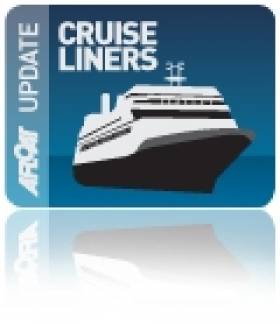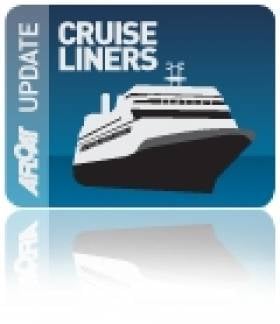Displaying items by tag: Glengariff
#CruiseLiners - A big cruiseship by Banty Bay standards involved notably a maiden call visit today to the scenic west Cork anchorage, writes Jehan Ashmore.
The megayacht-like Seabourn Quest of 32,000 tonnes had yesterday called to Cobh, Cork Harbour, before making an arrival in Bantry Bay this morning. To mark the maiden call, a reception was held on board where the harbourmaster of Bantry Bay Port Company and Bantry Business Assocation exchanged gifts with the ship's master.
Operating at the high-end of the luxury cruise-sector, Seabourn Quest has a guest capacity for only 498 passengers. The sleek twin-funnelled Seabourn Quest whose godmother is the English fashion icon and actress Twiggy, entered service in 2011. The ship regarded as a game -changer at the top end of the market was built by Italian yard of T. Mariotti yard in Genoa.
The operators claim the Spa at Seabourn is the largest on any ultra-luxury ship, at 11,400 square feet which encompasses both indoor and outdoor spaces spread over two decks.
Only Prinsendam of Holland America Line eclipses the current caller to the West Cork destination in terms of tonnage, at 39,000 tonnes. The cruiseship according to the port's website had made a call in May.
In total, 10 cruise callers are scheduled to call to Bantry Bay this season, though not all cruiseships will take anchorage off Bantry where five are planned before the season ends in September. Equally the same number of callers will by the end of season, anchor off neighbouring Glengariff with its attractions, among them Garnish Island.
The next port of call for Seabourn Quest is Foynes, where the Shannon estuary port is a more unusual destination to receive cruiseships.
Bantry Bay Cruise Scene: A Setting for A Sapphire
#BantryCruiseships – As previously reported, Serenissima (1960/2,598grt) a 110 passenger exploration cruiseship which called to Glengariff mid-week was yesterday followed by Saga Sapphire to the secluded west Cork anchorage, writes Jehan Ashmore.
Operated by Serenissima Cruises, she reflects a different era with classically designed hull forms and overall appearance of an era that remains with the Hurtigruten final traditional ship, Lofoten which celebrates her 50th anniversary this year.
Saga Sapphire (1981/37,301grt) with a 710 passenger capacity is easily the largest cruise ship caller this season to call to Bantry Bay. Operated by Saga Cruises, she had sailed from Killybegs, having also visited Belfast and Dublin.
She is the third caller this season out a total of six to visit Bantry Bay Port which at the turn of this year, saw responsibility for the control of Bantry Bay Harbour transferred to the Port of Cork Company.
The transfer order was made by Minister for Transport, Leo Varadkar TD, and for the purposes of managing operations in Bantry Bay, the Port of Cork Company established a subsidiary company, Bantry Bay Port Company Limited.
To date, Le Boreal and Minerva have called in late May opening the cruise ship season which will also see Amadea call in August make a repeat visit in October to mark the end of the season.
As for the interim fifth visitor to call to Glengariff, Club Med 2 is to make an appearance in September, her 'tallship' presence will further add to the allure of cruising is such a scenic setting.
As there are no berthing facilities to cater for cruiseships alongside charming Glengariff, this all lends to the experience of anchoring in the surrounds of beautiful Bantry Bay.
Nearby is Garnish Island, where many visitors take the small ferry service to the island, where the world renowned gardens are laid out with specimen plants that are rare in this climate.
Glengarriff harbour has a small pontoon to assist with embarkation at the quayside
Cruise Caller Line-Up for Galway Harbour
#CRUISE LINERS- Galway Harbour can look forward to welcoming nine cruise calls to the mid-west port this year, with the first visitor being Arion which is scheduled to arrive in Galway Bay during late May, writes Jehan Ashmore.
Arion harks back to an era of the more classically designed ships with graceful sweeping lines. The 5,888 tonnes veteran vessel was launched in 1965 at Pula, in Croatia, as Istra and later in her career she underwent a major reconstruction in a Lisbon shipyard during 2000.
Cruise & Maritime Voyages (CMV) will be sending their Marco Polo, another classic veteran, in July as part of a 12 night 'Emerald Isle' discovery cruise departing Tilbury, with en-route calls to Cobh and Glengariff the previous day.
For a full listing of the cruise-calls schedule click HERE.
German Cruise-Goers On Anchorage Call to Glengariff
At 192m in length, the 600-passenger capacity cruiseship is operated by Pheonix Reisen. The German based travel agency also runs fleetmates Albratross and Artania. The later Finish built vessel was best known as Princess Cruises Royal Princess, when launched by the late Diana, Princess of Wales in 1984.
Apart from the handful of cruiseships that call, Bantry Bay is otherwise used by oil tankers bringing supplies to the Whiddy Island Oil Terminal. The terminal consists of an offshore single point mooring, tanker Jetty, and an onshore tank farm. The bay runs some 35kms long and is 10km wide at its broadest at the entrance and steadily narrows to 3-4kms at its head. In addition the bay is largest of the main inlets in the south-west.
Glengariff in recent years has also welcomed another German operator, Peter Deilmann's Deutschland (1988/22,496grt) and the UK based Cruise & Maritime Voyages Marco Polo (1966/20,080grt). To read more on this vessel which regularly calls to Irish ports click HERE.

































































